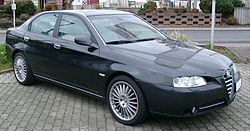| Model | Engine | Displacement | Power | Torque | 0–100 km/h (0–62 mph), seconds | Top Speed | Note |
|---|
| First generation of engines, MY 1999-2000 |
|---|
| 2.0 TS | 16V I4 | 1,970 cc | 155 PS (114 kW; 153 hp) at 6,400 rpm | 187 N⋅m (138 lb⋅ft) at 2,800 rpm | 9.6 | 213 km/h (132 mph) | Euro2 |
| 2.0 V6 TB | 12V V6 | 1,996 cc | 205 PS (151 kW; 202 hp) at 6,000 rpm | 285 N⋅m (210 lb⋅ft) at 2,500 rpm | 8.1 | 237 km/h (147 mph) | Turbo, Italian tax model |
| 2.5 V6 | 24V V6 | 2,492 cc | 190 PS (140 kW; 187 hp) at 6,200 rpm | 222 N⋅m (164 lb⋅ft) at 5,000 rpm | 8.4
9.5 Sportronic | 225 km/h (140 mph)
220 km/h (137 mph) Sportronic | Euro2 |
| 3.0 V6 | 24V V6 | 2,959 cc | 226 PS (166 kW; 223 hp) at 6,200 rpm | 275 N⋅m (203 lb⋅ft) at 5,000 rpm | 7.8
8.5 Sportronic | 243 km/h (151 mph)
237 km/h (147 mph) Sportronic | Euro2 |
| 2.4 JTD | 10V I5 | 2,387 cc | 136 PS (100 kW; 134 hp) at 4,000 rpm | 304 N⋅m (224 lb⋅ft) at 2,000 rpm | 9.9 | 202 km/h (126 mph) | |
| Second generation of engines, MY 2001-2003 |
|---|
| 2.0 TS | 16V I4 | 1,970 cc | 150 PS (110 kW; 148 hp) at 6,300 rpm | 181 N⋅m (133 lb⋅ft) at 3,800 rpm | 9.8 | 211 km/h (131 mph) | Euro3 |
| 2.5 V6 | 24V V6 | 2,492 cc | 188 PS (138 kW; 185 hp) at 6,300 rpm | 221 N⋅m (163 lb⋅ft) at 5,000 rpm | 8.4
9.5 Sportronic | 225 km/h (140 mph)
220 km/h (137 mph) Sportronic | Euro3 |
| 3.0 V6 | 24V V6 | 2,959 cc | 220 PS (162 kW; 217 hp) at 6,300 rpm | 265 N⋅m (195 lb⋅ft) at 5,000 rpm | 7.8
8.6 Sportronic | 241 km/h (150 mph)
237 km/h (147 mph) Sportronic | Euro3 |
| 2.4 JTD | 10V I5 | 2,387 cc | 140–150 PS (103–110 kW; 138–148 hp) at 4,000 rpm | 305 N⋅m (225 lb⋅ft) at 1,800 rpm | 9.9 | 210 km/h (130 mph) | |
| Third generation of engines, MY 2004 Facelift-2007 |
|---|
| 2.0 TS | 16V I4 | 1,970 cc | 150 PS (110 kW; 148 hp) at 6,400 rpm | 181 N⋅m (133 lb⋅ft) at 3,800 rpm | 9.8 | 211 km/h (131 mph) | |
| 2.5 V6 | 24V V6 | 2,492 cc | 188 PS (138 kW; 185 hp) at 6,300 rpm | 221 N⋅m (163 lb⋅ft) at 5,000 rpm | 8.4 | 225 km/h (140 mph) | |
| 3.0 V6 | 24V V6 | 2,959 cc | 220 PS (162 kW; 217 hp) at 6,300 rpm | 265 N⋅m (195 lb⋅ft) at 5,000 rpm | 8.6 Sportronic | 236 km/h (147 mph) Sportronic | |
| 3.2 V6 | 24V V6 | 3,179 cc | 240 PS (177 kW; 237 hp) at 6,200 rpm | 289 N⋅m (213 lb⋅ft) at 4,800 rpm | 7.4 | 245 km/h (152 mph) | |
| 2.4 JTD | 10V I5 | 2,387 cc | 150 PS (110 kW; 148 hp) at 4,000 rpm | 305 N⋅m (225 lb⋅ft) at 1,800 rpm | 9.9 | 210 km/h (130 mph) | |
| 2.4 JTD M-Jet | 20V I5 | 2,387 cc | 175–185 PS (129–136 kW; 173–182 hp) at 4,000 rpm | 385 N⋅m (284 lb⋅ft) at 2,000 rpm
330 N⋅m (243 lb⋅ft) at 1,750 rpm (Sportronic) | 8.9
8.9 Sportronic | 222 km/h (138 mph)
218 km/h (135 mph) Sportronic | (depending on model year) |
|



